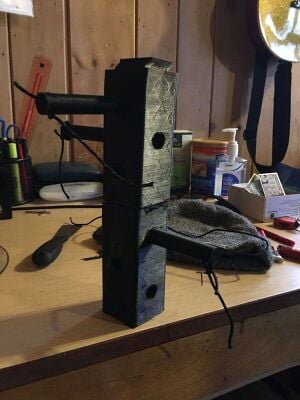
With recent destruction of coral reefs due to marine pollution, there are movements within marine biology for conservation efforts of coral. When coral breaks off of its reef, it can regenerate if placed into a nourishing environment. To ashe sist with efforts to help grow these rare corals, I created a modular post that can be used to hold pieces of coral while they regrow. The posts are of a modular design, and can be built up to allow for more coral to be placed on a single vertical post. The rods slide through the post, and with string tied to the holes on each rod, are tied to the coral so it doesn't move. A weight is tied to the lowest rod in order to keep the vertical posts in place and prevent them from floating.
Bill of Materials[edit | edit source]
OS CAD files and STL's available:
Other Pieces
- Weight with string for attachment (Heavy object that will sink)
- 2x String/rod (Approximately 5 in. long)
Tools needed[edit | edit source]
- MOST Delta RepRap or similar RepRap 3-D printer
- Sandpaper, drill with variable drill-bits (Clean-Up of parts)
- Hammer/Mallet (just in-case rods need more help)
Technical Specifications and Assembly Instructions[edit | edit source]
- Provide directions for print/assembly - be detailed enough in your "how to" to ensure that someone could construct the device from your description.
- Print the post and at least two rods
- . Sand down pieces so rods fit into the post
- Slide the two rods into the post
- Tie the weight to the lowest rod
- Tie string onto holes of highest rods (vary rod locations when using more post)
- Tie coral to string
- If more coral is acquired, print more posts and rods and repeat Steps 2-6 (skip step 4 and make sure to sand the connections for the posts)
- Print Time Estimate:
- Rod: 1 hour 19 minutes (70mm/sec, 10% infill, support generated everywhere)
- Modular Post: 4 hours 25 minutes (70mm/sec, 10% infill, support generated everywhere)
- Include assembly time estimate
- With clean-up, assembly should take less than 15 minutes
Common Problems and Solutions[edit | edit source]
- The vertical post more than likely will not fit into one another directly after printing. Light sanding will more than likely be required on edges to enable a quality fit.
- The sanding will have to occur on the rods as well. If the holes on the post are not large enough, ream them with a drill-bit.
Cost savings[edit | edit source]
Rods are roughly 15g (10% infill) and Post are 73g (10% infill). Given an approximate cost of $0.04/gram, one set (one post and one rod) cost close to $3.50.
There does not seem to be a commercial equivalent currently.
Benefited Internet Communities[edit | edit source]
References[edit | edit source]